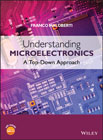
This book starts with processing functions and signals and their properties, and then analyses the features of many electronic systems. It studies buildingblocks like transistors and passive components at a functional level, with special attention on their practical limitations and associated realization problems. This study encourages learning at increasing levels of detail while it is covered in both analog and digital solutions. The validity of the theory described is proved in numerous examples, simulations, exercises, and verification results. Author is well-known and respected in academia, as well as being anaward-winning practitioner. Teaches with a unique 'top-down' method that begins with processing functions, then describes signals and their properties before analyzing the features of many systems; it explains a global view before going into specifics State-of-the-art in that this method follows the evolution of CAD tools that are focusing more on high-level design. A useful balance of theory, example and verification of results. Supplies a number of computer examples whose source code will be available for download on a supplementary website. INDICE: Preface xix 1 Overview, Goals and Strategy 1 1.1 Good morning, 1 1.2 Planning the Trip 4 1.3 Electronic Systems 5 1.3.1 Meeting a System 8 1.4 Transducers 11 1.4.1 Sensors 12 1.4.2 Actuators 15 1.5 What is the role of the computer? 17 1.6 Goal and Learning Strategies 19 1.6.1 Teamwork Attitude 20 1.6.2 Creativity and Execution 20 1.6.3 Use of Simulation Tools 21 1.7 Self Training, Examples and Simulations 22 1.7.1 Role of Examples and Computer Simulations 22 1.8 Business Issues, Complexity and CAD Tools 23 1.8.1 CAD Tools 24 1.8.2 Analog Simulator 24 1.8.3 Device and Macro-block Models 25 1.8.4 Digital Simulation 26 1.9 ELectronic VIrtual Student Lab (ElvisLab) 27 2 Signals 31 2.1 Introduction 31 2.2 Type of Signals 35 2.3 Time and Frequency Domains 46 2.4 Continuous-time and Discrete-time 51 2.4.1 The Sampling Theorem 55 2.5 Using Sampled-Data Signals 57 2.5.1 The z-transform 58 2.6 Discrete-amplitude 60 2.6.1Quantized Signal Coding 64 2.7 Signals Representation 66 2.7.1 The Decibel 662.8 DFT and FFT 69 2.9 Windowing 71 2.10 Good and Bad Signals 76 2.10.1 Oset 76 2.10.2 Interference 77 2.10.3 Harmonic Distortion 79 2.10.4 Noise 82 2.11 THD, SNR, SNDR, Dynamic Range 87 3 Electronic Systems 95 3.1 Introduction 95 3.2 Electronics for Entertainment 96 3.2.1 Electronic Toys 96 3.2.2 Video Game and Game Console 100 3.2.3 Personal Media Player 101 3.3 Systems for Communication 103 3.3.1 Wired Communication Systems 103 3.3.2 Wireless: Voice, Video andData 105 3.3.3 RFID 107 3.4 Computation and Processing 109 3.4.1 Microprocessor 109 3.4.2 Digital Signal Processor 111 3.4.3 Data Storage 113 3.5 Measure, Safety and Control 114 3.5.1 The Weather Station 114 3.5.2 Data Fusion 115 3.5.3 Systems for Automobile Control 118 3.5.4 Noise Canceling Headphone 120 3.6 System Partitioning 123 3.7 System Testing 124 4 Signal Processing 127 4.1 What is Signal Processing? 127 4.2 Linear and Non-Linear Processing 131 4.3 Analog and Digital Processing 136 4.3.1 Timing for Signal Processing 139 4.4 Response of Linear Systems 141 4.4.1 Time Response of Linear Systems 141 4.4.2 Frequency Response of Linear Systems 145 4.4.3 Transfer Function 148 4.5 Bode Diagram 150 4.5.1 Amplitude Bode Diagram 151 4.5.2 Phase Bode Diagram 155 4.6 Filters 158 4.6.1 Analog Design and Sensitivity 162 4.6.2 Sampled-Data Analog and Digital Design 167 4.7 Non-linear processing 169 5 Circuits for Systems 181 5.1Introduction 181 5.2 Processing with Electronic Circuits 183 5.2.1 ElectronicInterfaces 184 5.2.2 Driving Capability 188 5.2.3 Electrostatic Discharge Protection 191 5.2.4 DC and AC Coupling 193 5.2.5 Ground and Ground for Signal 197 5.2.6 Single-ended and Di erential Circuits 198 5.3 Inside Analog ElectronicBlocks 201 5.3.1 Simple Continuous-time Filters 203 5.3.2 Two Poles Filters 205 5.4 Continuous-Time Linear Basic Functions 206 5.4.1 Addition of Signals 206 5.4.2 The Virtual Ground Concept 210 5.4.3 Multiplication by a Constant 212 5.4.4 Integration and Derivative 214 5.5 Cont
- ISBN: 978-0-470-74555-7
- Editorial: John Wiley & Sons
- Encuadernacion: Cartoné
- Páginas: 704
- Fecha Publicación: 11/11/2011
- Nº Volúmenes: 1
- Idioma: Inglés
